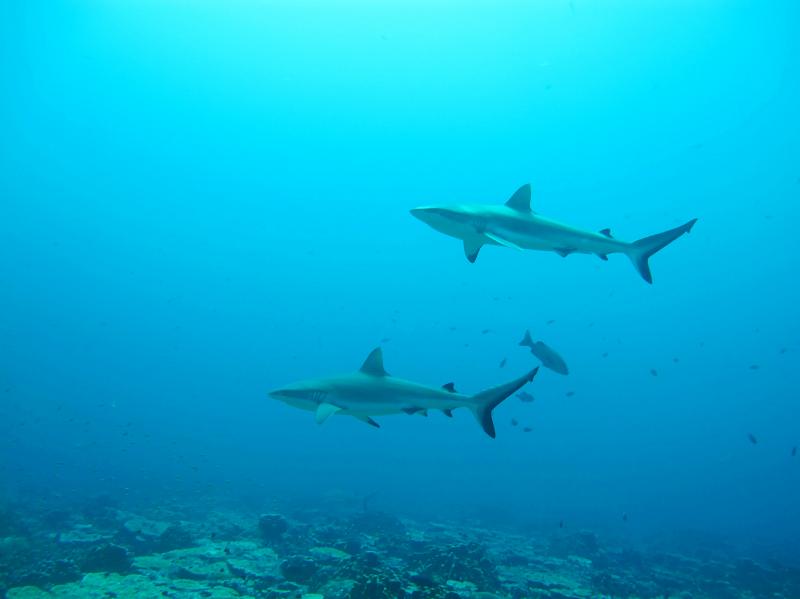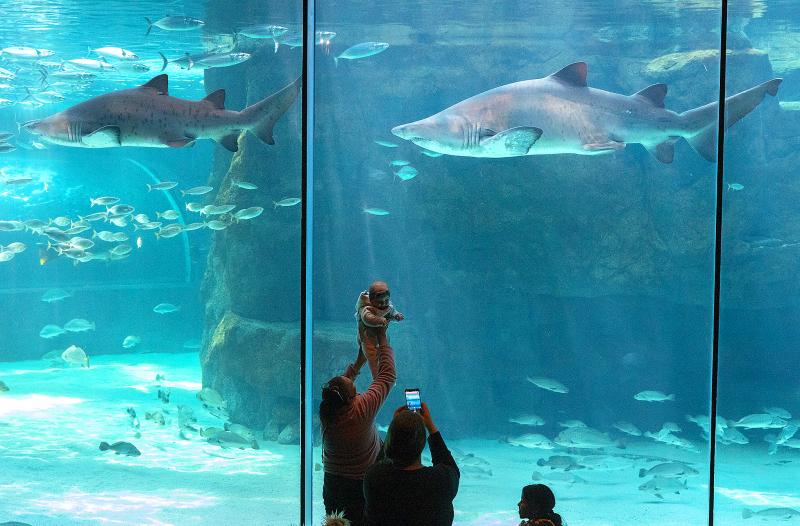The partial skull of an armored fish that swam in the oceans over 400 million years ago could turn the evolutionary history of sharks on its head, researchers have said.
Bony fish, such as salmon and tuna, as well as almost all terrestrial vertebrates, from birds to humans, have skeletons that end up made of bone. However, the skeletons of sharks are made from a softer material called cartilage — even in adults.
Researchers have long explained the difference by suggesting the last common ancestor of all jawed vertebrates had an internal skeleton of cartilage, with bony skeletons emerging after sharks had already evolved. The development was thought so important, living vertebrates are divided into “bony vertebrates” and “cartilaginous vertebrates” as a result.

Photo: Reuters
Among other evidence for the theory, the remains of early fish called placoderms — creatures with bony armor plates that also formed part of the jaws — shows they had internal skeletons made of cartilage.
But now a startling discovery has upended the theory: researchers have found the partial skull-roof and brain case of a placoderm composed of bone.
The fossil, about 410 million years old and reported in the journal Nature Ecology & Evolution, was unearthed in western Mongolia in 2012, and belongs to a placoderm that has been dubbed Minjinia turgenensis and would have been about 20-40cm in length.

Photo: EPA-EFE
“This fossil is probably the most surprising thing I have ever worked on in my career. I never expected to find this,” said Martin Brazeau of Imperial College London and first author of the research.
“We know a lot about [placoderm] anatomy and we have hundreds of different species of these things — and none of them has ever shown this kind of bone.”
The new discovery, he said, casts doubt on the idea that sharks branched off the evolutionary tree of jawed vertebrates before a bony internal skeleton evolved.
“This kind of flips it on its head, because we never expected really for there to be a bony internal skeleton this far down in the evolutionary history of jawed vertebrates,” said Brazeu. “This is the type of thing [which suggests] maybe we need to rethink a lot about how we think all of these different groups evolved.”
While the team say that one possibility is that bony skeletons could have evolved twice — once giving rise to the newly discovered placoderm species and once to the ancestor of all living bony vertebrates — they say a more likely possibility is that an ancestor of sharks and bony vertebrates actually had a bony skeleton, but that at some point in their evolutionary history the ability to make bone was lost in sharks.
Brazeau said the new findings adds weight to the idea that the last common ancestor of all modern jawed vertebrates did not resemble “some kind of weirdo shark” as is often depicted in text books. Instead, he said, such an ancestor more likely resembled a placoderm or primitive bony fish.
Daniel Field, a vertebrate palaeontologist at the University of Cambridge who was not involved in the work, welcomed the findings.
“Evolutionary biologists were long guided by the assumption that the simplest explanation — the one that minimized the number of inferred evolutionary changes — was most likely to be correct. With more information from the fossil record, we are frequently discovering that evolutionary change has proceeded in more complex directions than we had previously assumed,” he said.
“The new work by Brazeau and colleagues suggests that the evolution of the cartilaginous skeleton of sharks and their relatives surprisingly arose from a bony ancestor — adding an extra evolutionary step and illustrating that earlier hypotheses were overly simplistic.”

This month the government ordered a one-year block of Xiaohongshu (小紅書) or Rednote, a Chinese social media platform with more than 3 million users in Taiwan. The government pointed to widespread fraud activity on the platform, along with cybersecurity failures. Officials said that they had reached out to the company and asked it to change. However, they received no response. The pro-China parties, the Chinese Nationalist Party (KMT) and Taiwan People’s Party (TPP), immediately swung into action, denouncing the ban as an attack on free speech. This “free speech” claim was then echoed by the People’s Republic of China (PRC),

Exceptions to the rule are sometimes revealing. For a brief few years, there was an emerging ideological split between the Democratic Progressive Party (DPP) and Chinese Nationalist Party (KMT) that appeared to be pushing the DPP in a direction that would be considered more liberal, and the KMT more conservative. In the previous column, “The KMT-DPP’s bureaucrat-led developmental state” (Dec. 11, page 12), we examined how Taiwan’s democratic system developed, and how both the two main parties largely accepted a similar consensus on how Taiwan should be run domestically and did not split along the left-right lines more familiar in

Many people in Taiwan first learned about universal basic income (UBI) — the idea that the government should provide regular, no-strings-attached payments to each citizen — in 2019. While seeking the Democratic nomination for the 2020 US presidential election, Andrew Yang, a politician of Taiwanese descent, said that, if elected, he’d institute a UBI of US$1,000 per month to “get the economic boot off of people’s throats, allowing them to lift their heads up, breathe, and get excited for the future.” His campaign petered out, but the concept of UBI hasn’t gone away. Throughout the industrialized world, there are fears that

Most heroes are remembered for the battles they fought. Taiwan’s Black Bat Squadron is remembered for flying into Chinese airspace 838 times between 1953 and 1967, and for the 148 men whose sacrifice bought the intelligence that kept Taiwan secure. Two-thirds of the squadron died carrying out missions most people wouldn’t learn about for another 40 years. The squadron lost 15 aircraft and 148 crew members over those 14 years, making it the deadliest unit in Taiwan’s military history by casualty rate. They flew at night, often at low altitudes, straight into some of the most heavily defended airspace in Asia.